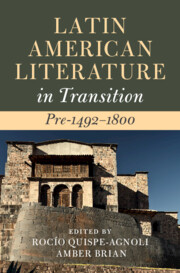Book contents
- Latin American Literature in Transition Pre-1492–1800
- Latin American Literature in Transition
- Latin American Literature in Transition Pre-1492–1800
- Copyright page
- Dedication
- Contents
- Figures
- Contributors
- Acknowledgments
- Introduction Dwelling in Transitions
- Part I Land, Space, Territory
- Chapter 1 Migrations and Foundations in the Literature of New Spain
- Chapter 2 Defining Portuguese America: The First Depictions of Brazil Within the Context of Overseas Expansion
- Chapter 3 The Conquest of Space in the Relación del Descubrimiento del Rio Marañón by Gerónimo de Ypori (c. 1630)
- Chapter 4 Disturbing Place: Afro-Iberian Herbalists Interrupt Imperial Cartagena de Indias
- Part II Body
- Part III Belief Systems
- Part IV Literacies
- Part V Languages
- Part VI Identities
- Index
- References
Chapter 1 - Migrations and Foundations in the Literature of New Spain
from Part I - Land, Space, Territory
Published online by Cambridge University Press: 25 November 2022
- Latin American Literature in Transition Pre-1492–1800
- Latin American Literature in Transition
- Latin American Literature in Transition Pre-1492–1800
- Copyright page
- Dedication
- Contents
- Figures
- Contributors
- Acknowledgments
- Introduction Dwelling in Transitions
- Part I Land, Space, Territory
- Chapter 1 Migrations and Foundations in the Literature of New Spain
- Chapter 2 Defining Portuguese America: The First Depictions of Brazil Within the Context of Overseas Expansion
- Chapter 3 The Conquest of Space in the Relación del Descubrimiento del Rio Marañón by Gerónimo de Ypori (c. 1630)
- Chapter 4 Disturbing Place: Afro-Iberian Herbalists Interrupt Imperial Cartagena de Indias
- Part II Body
- Part III Belief Systems
- Part IV Literacies
- Part V Languages
- Part VI Identities
- Index
- References
Summary
The classic notion of translatio (imperii, studii, etc.) can be advantageously deployed to examine the narrative construction of space and its bearing on identity formation. The concept covers the displacement of people, the political and spiritual changes wrought by such movements, and the renderings of these events in various media. In New Spain, such transitions were represented, in both visual and alphabetic texts, by migrations (the wandering Aztecs, the sea-fearing missionaries, the forlorn creoles) and urban foundations (the legendary Tollan, the otherworldly Puebla, the all-encompassing Mexico-Tenochtitlan) in which past, present, and future, as well as myth, history, and literature, overlap. This chapter will consider the representation of several key migrations and foundations that illustrate transitions from images to words and from myth to history, and back again, in New Spanish literature to highlight the role of place in the identity-formation processes that lead from pre-Hispanic Anahuac to modern Mexico.
Keywords
- Type
- Chapter
- Information
- Latin American Literature in Transition Pre-1492–1800 , pp. 17 - 33Publisher: Cambridge University PressPrint publication year: 2022



